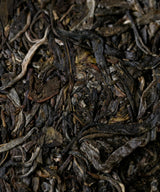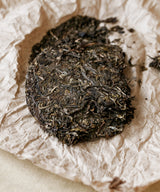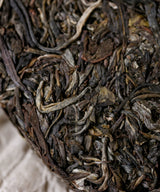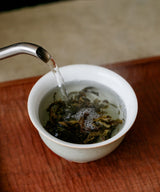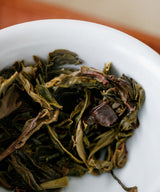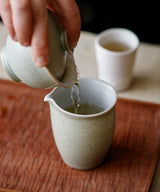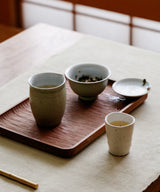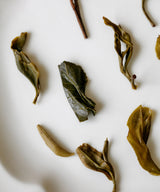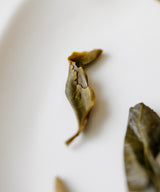Sacred Mountains 2021
Harvest
April 2021
Origin
Xishuangbannan, Yunnan
Pressed in extremely limited quantities, this one of the few pu’erh cakes we reserve for private collectors. We were fortunate to receive a small number of these tea cakes directly from our respected tea mentor in Beijing. Our mentor prefers remote and small-scale, old grove tea gardens. She is very fond of the 小叶种, or “small-leaf varietal,” of pu’erh. Compared to 大叶种, “big leaf varietal,” it is far more elusive and lesser known; the small-leaf tea is not commercially speculated and is rare to find on the market.
The six ancient tea mountains of Yunnan are 攸乐 You Le, 革登 Ge Deng, 倚邦 Yi Bang, 莽枝 Mangzhi, 蛮砖Manzhuan, and 易武 Yiwu. Sacred Mountain is crafted with tea leaves sourced from two of the oldest and most secluded ones among them, Xikong 习崆 in Yibang 倚邦 and Manzhuan 蛮砖.
Xikong is a remote, small village in Yibang, located at 4000 ft above sea level. On account of being so remote, the small number of ancient tea gardens here remain well preserved. We traveled to Yibang in 2019 to visit this ancient town and deepen our understanding of this region’s long history for producing sought-after pu’erh.
Among the six ancient tea mountains, Yibang is located at the highest altitude. It was once the starting point of the Ancient Tea Horse Road, a network of paths that connected the mountains of Sichuan and Yunnan, and the physical link to Tibet, Myanmar, Bengal and Laos.
I have vivid memories of the long, scenic and seemingly never-ending uphill journey to Yibang. It appears like a tiny, hidden gem inset between the magnificent mountain ranges that shield it, way up in the sky. Nowadays, the small village of Xikong 习崆 is home to only a few indigenous inhabitants. There are a number of rare, ancient tea trees here, scattered throughout the region’s deep forests.The mountain hills are steep and rocky; their soil is rich in clay and sand, and these features create an ideal environment for tea trees.
The lesser known, and more primitive 小叶种, “small leaf varietal,” of pu’erh trees are indigenous to this region and have been growing naturally in this remote area for thousands of years. Compared to the big leaf varietal, the buds and leaves are smaller, shorter and rounder. The tea brews to a vibrant yellow-green color, and their taste is distinct – gentle, and nuanced.
Only around 100 kg of tea are produced from the Xikong terroir for the Spring harvest. To make this tea the first harvest leaves sourced from two ancient tea gardens were blended together. 70% originates from Xikong, where the Pu’erh is known to be soft and gentle without being “thin,” and for its orchid notes with rich, honey undertones. The remaining 30% originates from Manzhuan, where the Pu’erh is known for being sweet and smooth with strong energy, and a long, lingering aftertaste. We find all of these characteristics in Sacred Mountain, combined to make something very unusual, and so remarkable.
This tea was my first encounter with the beautiful sensation of the Small-Leaf varietal. As many of you know, Pu’erh raw is my favorite tea, and one that I drink everyday. And as habitually familiar as I am with this kind of tea, I was completely astounded by Sacred Mountain: it is the most captivating, surprising, and delicious Pu’erh raw I have had in recent memory.
As I opened the paper folded around the tea cake I was met by the unexpected scent of dried tropical fruit. The liquor from the tea is a strange, light-trapping gold. As soon as you take a sip of it you will be captivated by trying to place the experience it offers. It is a very balanced tea, but unmissable – and as strong as it is sweet. It’s more angular floral notes linger for a long time on the palate, giving you an opportunity to breath them in. The Chinese phrase used to describe the sensation of the tea liquor is 细腻, which translates directly as, fine + intricate + exquisite + smooth + subtle + refined…imagine the synthesis of all of these things in your mouth, that is Sacred Mountain.
. . .
Brewing guide
The key to making this tea is using boiling water. The tea will start out being lighter for the first 2 infusions, until the leaves start to open up in the 3rd infusion. Quick infusions of around 10 seconds. It is best to use a neutral gaiwan to make this tea.
| Tea | 4 g |
| Temperature | 100°C |
| Water | 120 ml |
| Steep time | 10 - 60 sec |
| No. of infusions | 10+ |

